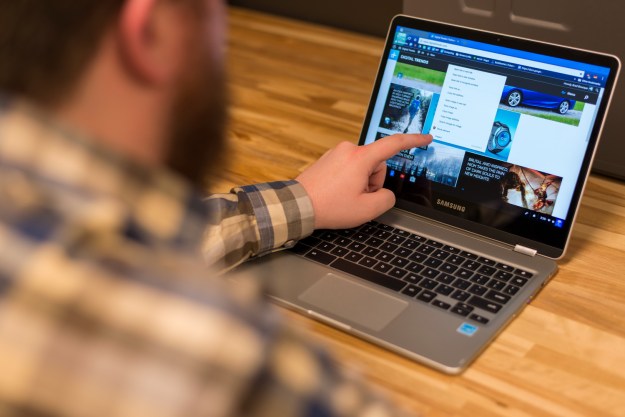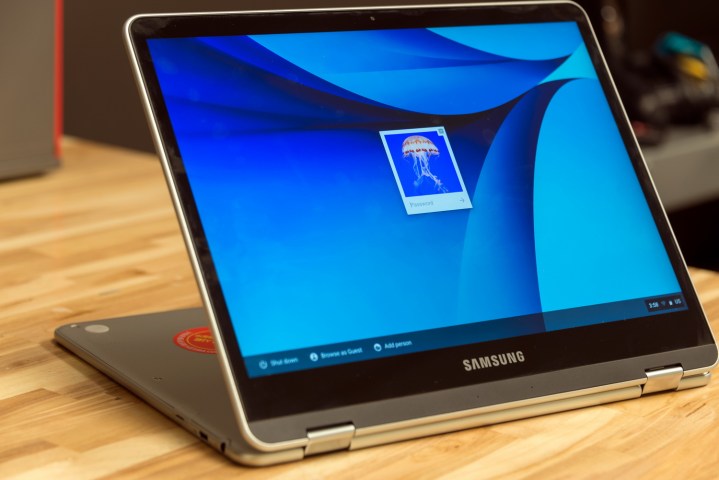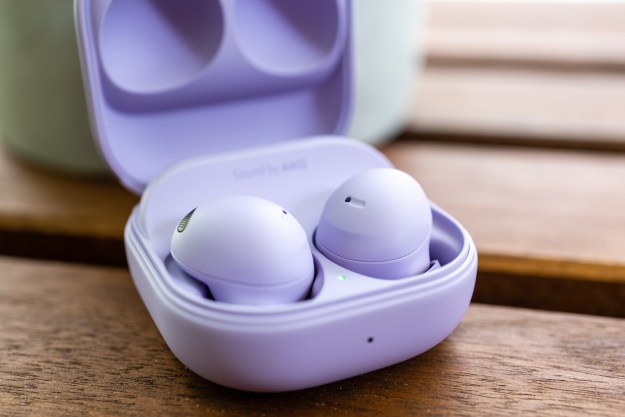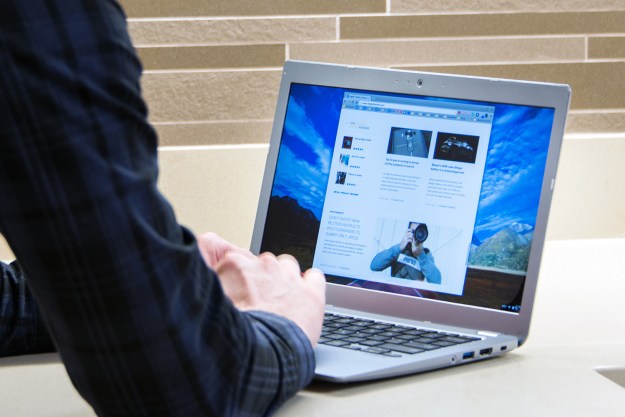
- Sturdy chassis
- Beautiful display
- Full Android app support
- Satisfying performance
- Compact design
- Cramped keyboard layout
- Middling battery life
Samsung’s Chromebook Pro and Plus for 2017 were the company’s next evolution in its Chromebook effort. The team at Samsung paired up with Google’s engineers to produce Chromebooks specifically designed to run apps from the Google Play Store, with motion controls and multi-touch compatible displays.
That doesn’t mean it isn’t a fully-featured Chromebook, too. The Samsung Chromebook Pro sports an Intel Core M processor, a 2,560 x 1,600 display, and multiple USB-C 3.1 ports. At $549, though, the Chromebook Pro is one of the more expensive Chrome OS options on the market. With a V2 of the Samsung Chromebook Plus on the market, is the original still worth the price of admission?
The hinged wonder
As far as Chromebooks go, Samsung’s offering is on the high-end. The magnesium alloy chassis feels sturdy to the touch. It’s important to note that there are two models of Samsung Chromebook, the Pro and Plus, but the major differences between the two are CPU and color.
Display quality is the best reason to consider the Samsung Chromebook Pro.
Our review model was the Pro, which features an Intel Core M processor. Ours was silver, but that is actually a darker shade on production units. In any case, the Pro is a simple but elegant machine. It’s not eye-catching, but also it’s inoffensive — something that’s becoming less competitive as more striking premium Chromebooks hit the market. HP’s excellent Chromebook x2 is a prime example, with its lovely “ceramic white” and metal color scheme.
The Chromebook Pro’s hinge is sturdy, and it finds the balance 360-degree hinges often lose. If you’re trying to tilt the screen, it’s easy to do, and the hinge will still hold the panel in place wherever you desir. This 2-in-1 works splendidly in both tent and laid-back modes.
Fold the Chromebook Pro all the way around, and it’s essentially an Android tablet, although it’s not quite that simple. The power and volume buttons fall on the keyboard unit, so they’re behind the tablet portion when flipped all the way around. It’s not the easiest to use as a dedicated tablet, but it’s far from the most awkward, even though the detachable tablet Chromebook x2 provides for a better slate experience.
It might no longer be the best 2-in-1 at this price point, but the Samsung’s small size and light weight nevertheless make it easy enough to handle. We also love the screen. More on that in a moment.
The Samsung Chromebook Pro has limited wired connectivity, which doesn’t come as much of a surprise considering its size or intended use case. There’s a USB-C port on each side of the system, with headphones and a MicroSD slot tucked away on the left side to go with a 3.5mm headphone jack.
While that might seem limiting to a lot of users, one or two Type-C ports are quickly becoming the standard for compact, lightweight systems. For most of the situations you’ll find yourself in with a Chromebook, wired video out ports are a luxury, or completely unnecessary. Still, if you often need to present from a projector or stream to a TV without a Chromecast, you’ll need an adapter.
Cramped, but enjoyable
Of the two most important keyboard qualities, size and key-feel, the Samsung nails just the latter. Each key on the Chromebook Plus is responsive, sturdy, and clicks satisfyingly, providing deep travel not usually found on such small systems.
However, the keyboard layout feels cramped, and will feel doubly so to people making the move from larger Windows and Mac laptops. Important keys like backspace and tab are too narrow, which is not an uncommon issue on smaller Chromebooks. There’s also no backlighting, which seems like a notable absence for the price point, and we once again reference the Chromebook x2 as an example of a Chrome OS 2-in-1 that manages to provide a more natural keyboard experience.
The trackpad is somehow even more disappointing. It’s small, particularly compared to the sprawling glass touchpads we’ve seen on systems like the XPS 13 and Apple’s MacBook line. As such, some of the Chrome OS gestures can feel a little cramped. Thanks to the touchscreen, you can simply drag around the screen if it grows frustrating, but users sitting at a desk will want to look for an external mouse.
Samsung is one of a growing number of manufacturers to offer a digitizer stylus with its Chromebook, with HP and Google as to others. The Chromebook Pro’s version slips away into the back-right corner on the base of the laptop, popping out with a clicking button on its exposed end. Removing it will trigger a pop-up context menu that allows the user choose its functionality. Apart from standard touch and handwriting modes, there’s also a laser pointer mode, magnifying glass, and a selection mode for capturing screenshots.
It may not be useful in all situations, especially in Chrome web apps, but the pen can help with precise touches in Android apps. It also has handwriting recognition through Google Keep, which allows you to quickly jot down notes and even search them, assisted by Google’s deep learning. It isn’t the most well-supported feature at the moment, certainly not the equal of Microsoft’s Windows 10 Ink, but frequent note-takers may find themselves reaching for the stylus on a regular basis.
A lovely display
For this high-end Chromebook, Samsung reached for a 2,400 x 1,600 display, which boasts a pleasantly high 235 PPI and is equaled by the Chromebook x2. The Asus Chromebook Flip C302CA only packs in a 1080p screen, while the HP Chromebook 13 does bumps the resolution up to 3,200 x 1,800.
The Samsung has an advantage with its unusual 3:2 aspect ratio, which we’ve seen become more common on touchscreen devices. The ratio makes the display far closer to a square than most, when in turn makes the system feel more tablet-like, and gives Android apps plenty of room to run in both landscape or portrait mode. It’s an important detail that even most
The keyboard layout feels cramped.
When discussing display quality, we often reach for our Spyder5Elite, a calibration tool that runs a gamut of tests while measuring the effective output of the display. We don’t have that luxury on our Chromebook because Chrome OS is not compatible with the test software, so we’ll have to rely on subjective impressions.
We came away impressed with not just the contrast and color accuracy, but with general screen quality. Colors had a full, vivid quality to them, while avoiding the neon-tinted blues and greens that often come along with that. Black levels were satisfyingly deep, giving bright spots a chance to truly shine.
That’s good news for the Samsung, particularly in a category where displays aren’t necessarily taken as seriously as they are in other laptops. Here, the Samsung’s panel can shine even brighter than it might otherwise. Its closest competitor, the HP Chromebook x2, is the Chromebook Pro’s equal — making these two of the best notebook displays you’ll find at this price point.
The Samsung Chromebook Pro suffers from a problem that many smaller systems share — audio quality. With a pair of downward-facing speakers, it was immediately clear the Chromebook wasn’t going to offer up anything besides basic sound reproduction.
On the other hand, we found the speakers were more than loud enough to fill a small room with sound. Not that you’d want them to run at that volume, where they cracked and sputtered audibly. Instead, at half-mast, the volume was comfortable enough to show off a Youtube video to a small group without it sounding like the speakers were stuffed in a tin can.
Usually fast enough, but the Intel chip has limits
Our review unit, the Samsung Chromebook Pro, was powered by an Intel Core m3-6Y30, a dual-core chip with a 900MHz base clock, 2.2GHz Turbo Boost, and Hyper-Threading. It’s a well-equipped, if low-power, option for a higher-end Chromebook. It’s the same chip found in the Asus C302CA, and just shy of the Core m5 found in the HP Chromebook 13 or even the newer 7th-gen Core m3-7Y30 on the Chromebook x2.
The other version of this system, the Samsung Chromebook Plus V2, is powered by a slower Intel Celeron CPU. That would save you $100 off the sticker price, but you’ll find performance suffers.
Our Chromebook testing process doesn’t have many actual performance benchmarks to lean back on, due to compatibility issues with most benchmarks. That said, we found the performance to be more than adequate for most users, and in most daily use cases. The system occasionally stuttered or hung for a few moments, but only if there were a lot of tabs open. In fact, we most often saw the gears slip a bit when we were switching back and forth between Google Play apps and Chrome-based software.
Android apps are one of the stronger performance points on the Chromebook Pro. The Core m3 chip is faster than basically anything you’d find in a standard
Time to play
Often, the software section in our laptop reviews sticks to any bundled software, or lack thereof. In the Samsung’s case, it’s a big piece of the puzzle. The Chromebook Pro and Plus are the first systems designed with Chrome OS and Google Play in mind, with accelerometer and gyroscopes for tilting and steering in games, and a digitizer touch pen for quick notes.
It’s a solution that feels a little rushed, even if it is still in its beta stages. Android apps work as expected, and the fact that
For example, the back button is commonly used on Android phones and tablets, but you’ll have to reach up to the back arrow in the upper left corner of your keyboard, or on the screen, to use it. Similarly, messaging apps don’t often use the “enter” key on an
Ultimately, if something is already working well in the browser on Chrome OS, you’re better off sticking with that instead of switching to the Android version. For us, that meant Google Play apps were often relegated to niche status – playing games like Fallout Shelter or Hearthstone, and the Netflix app lets you download some TV shows and movies.
Portable enough
At just .55 inches thick, Samsung’s Chromebook Pro fits in right alongside the thinnest systems we’ve tested. Its compact size shouldn’t be a problem for anyone, even those with small work bags. It’s also about a third of a pound lighter than the Asus, although neither is light enough for long-term tablet use — unlike the tablet portion of the Chromebook x2 that weighs a scant 1.62 pounds and is only .33 inches thick.
As far as battery life goes, the Samsung doesn’t impress as much as we’d hoped going in. Its 39-watt hour battery isn’t large by modern standards, especially considering the 45 watt-hours provided in the Chromebook x2, but it’s still a decent size for a small, efficient Chrome OS laptop.
It’s not the easiest to use as a tablet, but also far from the most awkward.
Even so, we saw a modest five hours and 14 minutes in the Peacekeeper browser benchmark loop — easily the most demanding battery test in our arsenal. The Asus stayed alive an hour longer. Some Chromebooks we’ve tested, like the Acer Chromebook 15, Lenovo IdeaPad 100S, and Acer Chromebook R11, have hit six and half to seven hours.
The Samsung Chromebook Pro lasted a respectable but not outstanding nine hours and 37 minutes in our video loop test, which loops a 1080p video file. That’s better than the Asus Chromebook C302CA, which lasted eight hours and five minutes. However, the best Windows laptops can last longer, with many hitting 10 hours of endurance or more.
We had hope the Chromebook Pro might last longer, given its premium position – but to be fair, it does defeat other high-end Chromebooks, and represents the upper end of endurance in Chrome OS systems.
Our Take
Samsung’s Chromebook Pro is a premium, ambitious system, with a lot going for it when it comes to design and feature set. There’s some awkwardness associated with Google Play’s recent introduction to Chrome OS, but the problems are minor, and potentially solvable in software. It carries a premium price for the category, but still comes in well under even the most budget-friendly Windows machines.
Is there a better alternative?
There are several other Chromebooks at the high-end price point for the category. The most immediately comparable system is HP Chromebook x2, which costs roughly the same at $599 but offers a more attractive and usable form factor.
HP’s Chromebook 13 shoots a bit more straight down the middle, with a 3,200 x 1,800 panel, backlit keyboard, and core m5 CPU. It lacks the 360-degree hinge, but may be a more appropriate fit if you don’t see yourself playing a lot of games or already have an Android tablet.
You could also spend far less on a Chromebook, but you’d have to compromise with lower-end CPU options, less RAM, and likely a 1,336 x 768 panel. You’d save a couple hundred dollars, but the day-to-day experience would be critically wounded compared to the Samsung. And you can forget about fancy features like stylus support, an accelerometer, or possibly even Google Play support. Not all Chromebooks will receive the update to enable it.
How long will it last?
Samsung’s Chromebook Pro represented a major step for Chromebooks. Its hardware is still relatively current, and it boast a rich feature set that you can expect to define the category for years to come. At launch, the Samsung Chromebook Pro is better equipped than any other Chromebook on the market to accept new features and software.
Should you buy it?
Yes. The Chromebook Pro remains a very good Chromebook and is the best 360-degree convertible 2-in-1 running Chrome OS. It nails some of the fundamental elements of a high-end Chrome OS device, including a high-resolution display. The Chromebook Pro has a few rough edges, and more traditional or less expensive Chromebooks could be the better pick for users who just want a very simple, intuitive laptop. Those who care about Chrome OS, though, will adore the Chromebook Pro’s advanced features.
Editors' Recommendations
- 7 best Chromebooks for 2024: the best for every budget
- 9 best 2-in-1 laptops in 2024: tested and reviewed
- Best Samsung Galaxy deals: S24, Buds, Watches and more
- The best 2-in-1 gaming laptops for 2024
- This one feature could prevent motion sickness, but the Vision Pro doesn’t have it










